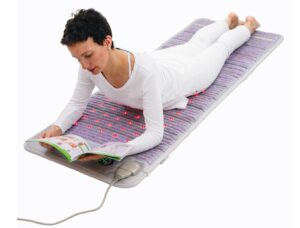Let’s face it—no one wants to go through life letting their health issues hold them down. You’ve got one life to live and you deserve to enjoy it as much as possible! Regardless of the health and wellness condition, there are a number of ways to reduce pain. These include everything from medication and therapy to holistic healing methods. But what is PEMF treatment? And does PEMF work? In this blog, we’ll cover how PEMF treatment for arthritis, back pain, migraines, and even PEMF treatment for lyme disease can all be utilized in a simple and effective way.
If you haven’t heard of PEMF, you are not alone! PEMF therapy, or pulsed electromagnetic field therapy, is a form of electromagnetic therapy that aims to heal the body at a cellular level. In recent years, research and interest in PEMF has significantly grown and many swear by its benefits. But, like many new forms of treatment, there are a lot of questions and skepticism about it. We’re here to clear the air so you can have a full understanding of this innovative form of therapy.
When first hearing about PEMF, most people ask “what can PEMF treat” or “how does it work”. These are great questions! Keep reading to find the answer to these questions, along with learning how to use PEMF to treat certain conditions and which PEMF device is best.
What is PEMF and How Does It Work?
PEMF therapy releases magnetic waves into the body to heal it at a cellular level. When your cells are functioning at their best, your entire body will function at its best, too. But how does magnetic energy heal the body?
Many people don’t realize that the human body itself is actually electric in nature. Each of our individual cells have an electromagnetic charge. This charge influences how many nutrients are allowed to permeate through the cell membrane and how much waste can be expelled from cells. When cells don’t receive the necessary amounts of nutrients and can’t properly get rid of waste, they cannot function at their optimal level. This can lead to a plethora of health and wellness issues.
Luckily, PEMF is able to reset the electromagnetic charge of cells! But how does their charge fall out of place to begin with?
Over time, cells naturally lose their natural magnetic charge as you grow older. That is why people are more susceptible to health issues as they grow older. There’s also another factor that influences the magnetic charge of cells: EMFs.
EMFs, or electric and magnetic fields, are invisible waves of energy that are released by practically every electronic device such as household appliances, cell phones, and power lines. They are often referred to as “electrosmog” or “dirty electricity” due to the negative health effects associated with them. With long-term exposure EMFs are believed to throw off your cells’ electromagnetic charge. Common issues that stem from EMF exposure include inflammation, hormone imbalance, and genetic damage. The International Agency for Research on Cancer (IARC) has even stated that EMFs might be “possibly carcinogenic to humans.”
As scary as that may sound, PEMF can protect you from EMFs and electromagnetic imbalance. Not only that, but it can even reverse the negative effects that result from cellular imbalance, ensuring that you can remain at your peak wellness.
How is PEMF Measured?
The magnetic field that PEMF generates is measured by a few different parameters. Practically all different PEMF devices release different kinds of magnetic fields. Some even allow you to customize the magnetic wave. To understand what settings are best for certain conditions, you should first understand how magnetic waves are measured. The most important units of measurement include:
– Frequency
– Intensity
– Waveform
Let’s take a closer look at each of these measurements and how they affect the human body.
Frequency
The frequency of a magnetic field describes how fast it cycles. The most common unit of measurement for frequency is Hertz (or Hz) and describes how many times a magnetic field cycles each second. For example, a frequency of 1 Hz denotes that a magnetic field cycles one time each second, while a frequency of 50 Hz means that the field cycles fifty times per second. Different frequencies of PEMF can interact with cells in different ways, resulting in different health and wellness outcomes. That’s why it’s important to understand frequency is best for your condition!
Intensity
The intensity of a magnetic field measures the strength of that field. One of the most common units of measurement for PEMF intensity is gauss (G) and milligauss (mG). Keep in mind that 1 gauss is equal to 1000 milligauss.
Regardless of the intensity, all magnetic fields pass through the body. But the intensity describes how much the magnetic field will stimulate applied tissue. Furthermore, it’s a common misconception that a higher intensity will bring about better results. In reality, many research studies and trials have found that lower intensities are actually better for getting the health improvements you need!
Waveform
Waveform is a term that describes the shape of a magnetic wave. Similar to how different waveforms of sound waves generate different sounds, different shapes of PEMF waves can have different effects on the body. The most common used in PEMF devices include sine (or sinusoidal), square, sawtooth, and more. While there have been a number of studies that look at the effect of each waveform on the body, none have been able to determine with complete certainty that one waveform is better than another.
What Can PEMF Treat?

PEMF therapy is used for a wide range of reasons. These reasons include everything such as treating serious, chronic conditions or simply improving your wellness. For those that use PEMF for specific conditions, it is often difficult to know which settings are best or how to use PEMF in general. That’s why we wanted to put together a list of conditions that PEMF is effective at treating and which settings work best.
Before we dive into each condition, it’s important to note that PEMF affects everyone’s body differently. While the settings for each condition mentioned below have been demonstrated through medical research to be beneficial in managing symptoms, you should consult with a doctor or medical professional who is knowledgeable about PEMF to guide you on using PEMF.
Bone Health
The effects of PEMF in relation to bone health have been studied for decades. The FDA has even approved PEMF for treatment of delayed and nonunion bone fractures and for bone formation after spinal fusion surgery.
In regard to bone growth, one study found that PEMF treatment with intensities of 2 and 3 gauss were more effective than gauss or higher. Another study that used similar intensities demonstrated that square waves with a frequency of 1.5 Hz were effective at stimulating bone growth.
Arthritis
Arthritis is a condition that results in swelling and inflammation around the joints. There are dozens of different kinds of arthritis, but the most common are osteoarthritis and rheumatoid arthritis.
Research into the effects of PEMF on osteoarthritis determined that magnetic waves of 1.5 Hz and 1 gauss slowed the development of osteoarthritis lesions. Specifically looking at rheumatoid arthritis, a review of research found that PEMF emitted at 15 Hz was beneficial for tissue health and blood flow in joints, thus reducing the pain associated with arthritis.
Migraines
Migraines are severe and intense headaches that can often include symptoms such as nausea, numbness, and sensitivity to light or sound. Most treatment methods include over-the-counter or prescription medication, but PEMF offers an effective alternative form of treatment, too.
Almost all the research regarding electromagnetic therapy and migraines used transcranial magnetic stimulation, a more focused and targeted version of PEMF. For example, one study found that a magnetic field of 10 Hz has the potential to be preventative therapy for migraines. This same study found that approximately 71% of respondents reported a 75% reduction of headache severity and intensity after 4-5 sessions.
Multiple Sclerosis
Multiple sclerosis is a disease that affects the central nervous symptom in which the immune system attacks the protective myelin that covers nerve fibers. While there is no cure, there are many treatment methods used for managing symptoms—including PEMF!
A double-blind study was performed to determine the effects of PEMF on 30 patients with multiple sclerosis. A magnetic wave of 4 to 13 Hz and 50 to 100 milligauss was used in the study. After 2 months of treatment, subjects noticed a significant improvement in fatigue levels, cognitive function, mobility, vision, and more.
Back Pain
Back pain is experienced by nearly 65 million Americans each year. A considerable portion of those who experience back pain suffer from chronic back pain, which is categorized as back pain that is consistent for 3 or more months. Luckily, PEMF can offer a significant improvement in pain, especially when used with other modalities.
One randomized placebo-controlled trial used a 10 to 30 Hz and 350 milligauss PEMF (along with other traditional treatment methods) on 42 subjects suffering from chronic lower back pain. The subjects were split into two groups; one who were exposed to PEMF and one that was given a sham treatment. It was found that those exposed to the PEMF treatment experienced a more rapid improvement in both pain and disability compared to those who received the placebo, indicating that PEMF can help treat your back pain faster.
Wound Healing
PEMF is often used to assist with wound healing after an injury surgery. This is because it helps expedite cell growth and improve cell health.
A European study tested PEMF’s effect on wound healing between two groups who received PEMF treatment and a placebo treatment. Each PEMF session ran consecutively for 10 and 20 minutes at 33 and 7.8 Hz, respectively. They also used an extremely low intensity between 2.5 and 31 milligauss. A few days after treatment, it was found that wounds healed faster and healthier for those who received PEMF compared to those who received the sham treatment.
Fibromyalgia
Fibromyalgia is a chronic condition that causes pain in the muscles and bones. It is often accompanied by fatigue and sleep problems. There are many ways of treating fibromyalgia, such as medication and lifestyle changes, but PEMF has been demonstrated to help manage symptoms too!
One clinical trial looked to investigate how and if PEMF improves symptoms of fibromyalgia. The study used very low intensity levels and an 8 Hz square-wave magnetic field on 28 participants, while a sham treatment was used on 20. After six weeks, it was found that the group exposed to PEMF stimulation had reductions in pain after only one session as well as less pain overall, highlighting that low-intensity PEMF represents a safe and effective treatment for fibromyalgia pain.
Nerve Repair
Research has demonstrated that PEMF can be an effective tool for triggering nerve repair. This can be helpful for those who have nerve damage or degenerative nerve conditions. One study that demonstrated this found that PEMF that released a 2 Hz and 600 to 3000 milligauss magnetic field effectively enhanced regeneration of sciatic nerve in mice. Another study that used a similar 2 Hz, 3000 milligauss PEMF device demonstrated that PEMF can be considered an effective, safe, and tolerable treatment for peripheral nerve repair.
Chronic Lyme Disease
Chronic Lyme Disease, or CLD, occurs after treatment of Lyme disease. It is an often debated topic amongst the medical community, as some people who are diagnosed with CLD may not even be exposed to the bacteria that caused Lyme disease. Regardless, symptoms can usually include arthritis and multiple sclerosis, both of which we’ve already discussed. Other symptoms can often include chronic fatigue and inflammation. Fatigue is often well treated with the PEMF settings similar to those used to treat MS and fibromyalgia. Another study that looked at multiple sclerosis and inflammation found that 5-weeks of PEMF therapy with a frequency of 1-25 Hz can significantly reduce symptoms.
So, What’s the Best PEMF Device?
When it comes to purchasing a PEMF device, there are so many options—most of which claim they offer the best PEMF technology for improving health and wellness. That’s one of the reasons why so many people become overwhelmed when looking for PEMF. So we thought we’d share what we thought is the best solution for your needs!

We truly believe that the HealthyLine Platinum Mat Full is the best PEMF device on the market today. Unlike other PEMF devices, the Platinum Mat allows users to customize the frequency, intensity, waveform (between square and sine) and pulse duration of the PEMF. Each of these parameters are able to meet the exact settings previously mentioned for each condition. Not only that, but the Platinum Mat even comes with numerous other natural therapies such as far infrared heat, gemstone therapy, photon light therapy, and more. HealthyLine also offers a comprehensive warranty coverage so you can be ensured you never have to go without PEMF therapy!
